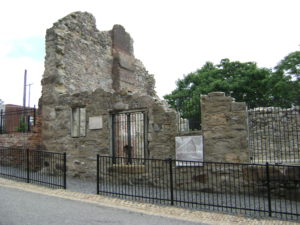 The prevailing opinion among historians is that the City of Petersburg is named for Peter Jones. If indeed this is the case, precious little historical information exists on the life of Peter Jones. His parents, his birthplace, and the dates of his birth and death are not positively known. The first mention of Peter Jones in the historical record is dated June 1, 1655, when a Peter Jones witnessed an agreement signed by Abraham Wood. In 1657, the Charles City County Records state that “Capt. Peter Jones have ye conduct and command of the particular company belonging to Coll. Abraham Wood and certify the same and he have power to command as it is or shall be directed by the laws of ye Country or by ye Collonell.”
The prevailing opinion among historians is that the City of Petersburg is named for Peter Jones. If indeed this is the case, precious little historical information exists on the life of Peter Jones. His parents, his birthplace, and the dates of his birth and death are not positively known. The first mention of Peter Jones in the historical record is dated June 1, 1655, when a Peter Jones witnessed an agreement signed by Abraham Wood. In 1657, the Charles City County Records state that “Capt. Peter Jones have ye conduct and command of the particular company belonging to Coll. Abraham Wood and certify the same and he have power to command as it is or shall be directed by the laws of ye Country or by ye Collonell.”
Peter Jones married Abraham Wood’s daughter Margaret, and they had five children: Abraham, Peter, Richard, William, and Mary. Peter Jones assumed Abraham Wood’s roles as a leader in Virginia military affairs and the Indian trade. “Peter Jones opened a trading establishment with the Indians, a few rods west of what is now the junction of Sycamore and Old Streets. This position for trade was called ‘Peter’s Point,’ subsequently changed to Petersburg.” Major Peter Jones was ordered to command Fort Henry in 1675, originally built in 1645, in order to defend against Indian unrest that subsequently fueled Bacon’s Rebellion. He is thought to have died about 1681, approximately one year before the death of Abraham Wood. In his will, Wood left most of his land holdings of several thousand acres to be divided equally among his four Jones grandsons.
In 1733, William Byrd II led a surveying trip that included Majors Mayo and Munford, John Banister, and the third Peter Jones, the grandson of the original Peter Jones. Byrd located and named what became the cities of Petersburg and Richmond. Richmond was laid out at the Falls of the James River, and the other city “at the Point of Appamattuck River [was] to be named Petersburgh.” The site of Byrd’s “Petersburgh” had been a settlement since the 1630s and 1640s, and the name “Peters Point” was already in use to designate the location.
For several generations of Peter Jones’s family, there was a Peter Jones. The second Peter Jones was born about 1655 and was referred to as Captain Peter Jones. He died about January 1727. Among his 10 children was the third Peter Jones, who was born about 1691. He was the Peter Jones who accompanied William Byrd II on his surveying expedition in 1733. He died in 1756, and among his 11 children was the fourth Peter Jones, who inherited the Fort Henry lands. The fourth Peter Jones died suddenly in 1756, and the Fort Henry property was left to his son, the fifth Peter Jones. He was born before 1728 and died about 1779. He erected Folly Castle in 1763, one of the three oldest homes in Petersburg. It is the signature home in the Folly Castle National Historic District and is located at 323 West Washington Street.
Suffice it to say that the original Peter Jones and the descendants who bore his name were community leaders in the in the civic, military, political, religious, and legal fields. They proved instrumental in the history and development of what became the City of Petersburg in the late 17th and 18th centuries.